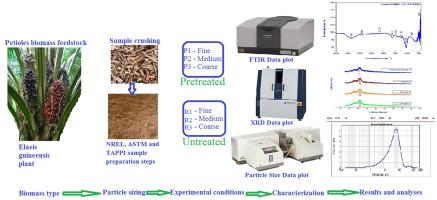活性表面积和颗粒大小对水热预处理生物质组分化合物最大可及性影响的实验研究
IF 5.8
2区 生物学
Q1 AGRICULTURAL ENGINEERING
引用次数: 0
摘要
实验框架探讨了如何最大限度地获取组分生物化合物,水热预处理的后续,主观的颗粒大小配置和反应表面积。假设样品粒度范围是评价水热预处理效率的关键参数。通过121℃、1.5atm高压灭菌2 h的水热预处理,实现了叶柄生物质细胞壁的解聚、降解和变性。采用Mastersizer 2000分析仪、FTIR和XRD分析,测定了水热预处理样品的转化效率。它展示了一个进化的方法在探索反应表面积,粒度配置和预处理的严重性。实验样品1、2和3表现出不同程度的转化,由于预处理和粒度的差异。实验数据表明,较小粒径范围(0-0.074 mm)的样品比较大粒径范围(0.150 mm和0.335 mm)的样品获得更多的活性表面积。未经处理的样品4显示最小的反应表面积和成分化合物的可及性差。这种新颖性在旨在最大化预处理效率的反应表面积的粒度配置分析中得到了部分证明。这种方法是促进生物燃料、生物能源和其他生物产品生产的先决条件。通过使用可推荐的粒度范围或阈值来保证最佳的可达性和低能耗,在生物炼制设计和优化中具有重要意义。本文章由计算机程序翻译,如有差异,请以英文原文为准。

Experimental examination of reactive surface areas and particle sizes configuration effects on hydrothermally pretreated biomass for maximal accessibility of constituent compounds
The experimental frameworks explored how to maximally access constituent biocompounds, sequel to hydrothermal pretreatment, subjective to particle size configuration and reactive surface areas. Particle size ranges of samples were hypothesized as crucial parameters required for the evaluation of hydrothermal pretreatment efficiency. Depolymerization, degradation and denaturation of petioles biomass cell walls were achieved through hydrothermal pretreatment done by autoclaving at 121 °C and 1.5atm for 2 h. The conversion efficiencies of the hydrothermally pretreated samples were instrumentally determined using Mastersizer 2000 analyzer, FTIR and XRD analyses. It demonstrated an evolutionary approach in the exploration of reactive surface areas, particle sizes configuration and pretreatment severity. The experimental samples 1, 2 and 3 exhibited diverse levels of transformations as a result of pretreatment and particle size differences. Experimental data showed that samples of smaller particle size ranges (0–0.074 mm) displayed access to more reactive surface areas than the higher particle size ranges (0.150 mm and 0.335 mm sieves). Untreated sample 4 showed minimal reactive surface areas and poor accessibility of constituent compounds. The novelty was partly demonstrated in particle sizes configuration analysis with reactive surface areas targeted at maximizing pretreatment efficiency. This approach is a prerequisite which aims to advance the production of biofuel, bioenergy and other bioproducts. It is significant in biorefinery design and optimization through utilization of recommendable particle size ranges or thresholds that guarantee optimal accessibility and low energy consumption.
求助全文
通过发布文献求助,成功后即可免费获取论文全文。
去求助
来源期刊

Biomass & Bioenergy
工程技术-能源与燃料
CiteScore
11.50
自引率
3.30%
发文量
258
审稿时长
60 days
期刊介绍:
Biomass & Bioenergy is an international journal publishing original research papers and short communications, review articles and case studies on biological resources, chemical and biological processes, and biomass products for new renewable sources of energy and materials.
The scope of the journal extends to the environmental, management and economic aspects of biomass and bioenergy.
Key areas covered by the journal:
• Biomass: sources, energy crop production processes, genetic improvements, composition. Please note that research on these biomass subjects must be linked directly to bioenergy generation.
• Biological Residues: residues/rests from agricultural production, forestry and plantations (palm, sugar etc), processing industries, and municipal sources (MSW). Papers on the use of biomass residues through innovative processes/technological novelty and/or consideration of feedstock/system sustainability (or unsustainability) are welcomed. However waste treatment processes and pollution control or mitigation which are only tangentially related to bioenergy are not in the scope of the journal, as they are more suited to publications in the environmental arena. Papers that describe conventional waste streams (ie well described in existing literature) that do not empirically address ''new'' added value from the process are not suitable for submission to the journal.
• Bioenergy Processes: fermentations, thermochemical conversions, liquid and gaseous fuels, and petrochemical substitutes
• Bioenergy Utilization: direct combustion, gasification, electricity production, chemical processes, and by-product remediation
• Biomass and the Environment: carbon cycle, the net energy efficiency of bioenergy systems, assessment of sustainability, and biodiversity issues.
 求助内容:
求助内容: 应助结果提醒方式:
应助结果提醒方式:


